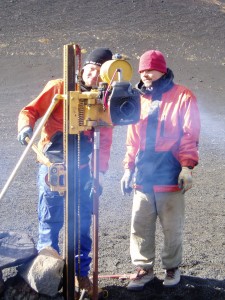I first came in contact with extremophiles during a lecture back in my hometown Salzburg, Austria. That day I learned that some organisms can not only survive harsh conditions – ph levels as low as 0, salt concentrations up to 30% and temperatures exceeding 100°C – but that they actually need such conditions to survive. After that lecture, I wanted to learn more about this group of organisms, the extremophiles. I continued my studies in Sydney, Australia, where I was fortunate enough to join a lab that investigates the microbial diversity of modern stromatolites. These living rocks off the coast of Western Australia may represent modern analogues to fossilized stromatolites found in rocks 3.5 billion years old. To further my understanding of extremophiles and their physiological properties, I spent 2 years at the NASA Ames Research Centre in California, in Lynn Rothschild’s lab. There, we examined the question of whether cyanobacterial toxins could have acted as an ancient UV-C screening cell constituent. We also investigated the resistance and repair mechanism of a halophilic Archaea to high UV radiation.

Stromatolites formed by cyanobacteria in Australia. Credits: cskk under creative comments license CC BY-NC-ND 2.0 https://flic.kr/p/4NTXfe
Now I’m working at the German Aerospace Centre in Cologne and our group is investigating several aspects of extremophiles and stress resistance. That is why we are involved in ESA’s CAVES project. Caves are a protected environment with no sunlight and very little nutrients, making it an extreme environment for its inhabitants.
 In June this year, I was fortunate enough to visit some of the caves myself, and I spent the night in one of them. This experience was amazing, as you cannot believe just how dark and silent it really is inside a cave. Deprived of senses like vision and hearing, your environment is very different than when the lights are on. And because not many people go into caves, human disturbances are very infrequent, which allows us to ask: “If humankind went beyond the moon to new planets, what type of contamination would we bring to these new worlds?” We therefore use different microbiological and molecular methods to investigate the microbiome of the cave and how human presence changes the natural composition of the environment.
In June this year, I was fortunate enough to visit some of the caves myself, and I spent the night in one of them. This experience was amazing, as you cannot believe just how dark and silent it really is inside a cave. Deprived of senses like vision and hearing, your environment is very different than when the lights are on. And because not many people go into caves, human disturbances are very infrequent, which allows us to ask: “If humankind went beyond the moon to new planets, what type of contamination would we bring to these new worlds?” We therefore use different microbiological and molecular methods to investigate the microbiome of the cave and how human presence changes the natural composition of the environment.
Stefan Leuko


Discussion: no comments